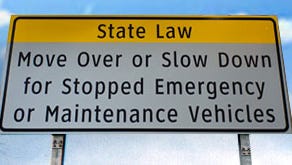


#Move over law driver
The Move Over Law requires you to move over a lane or slow down to 20 MPH below the speed limit. Article 1144-a requires a driver to move as far away as possible from an emergency vehicle that is displaying flashing lights and is stopped on a shoulder.

Do you stay in the right lane and fly by the officers car? No, You Move Over Move Over
#Move over law tv
TxDOT's TV and radio public service announcements, digital ads, and outreach efforts are helping to raise awareness of the Move Over or Slow Down law.Imagine you are driving down the Florida Turnpike at 70 MPH and you see an FHP officer on the right shoulder with their lights on and a car pulled over. If there is a crash that causes injury to a worker, drivers can be fined up to $2,000.
#Move over law code
On roadways with posted speed limits of 25 miles per hour or less, drivers must reduce their speed to 5 miles per hour (Texas Transportation Code 545.157).ĭrivers who fail to give emergency and work crews space to safely do their jobs can receive a ticket with a fine of up to $200. This law requires drivers to move over a lane or slow to 20 mph below the posted speed limit when approaching emergency vehicles, law enforcement, tow trucks, utility service vehicles, TxDOT vehicles or other highway construction or maintenance vehicles using visual signals or flashing lights activated on the roadside. The Move Over or Slow Down law, which traditionally has required drivers to yield to police, fire and emergency vehicles, has been expanded over the years to provide the same protection for TxDOT work crews and other roadside workers. The Move-Over Law requires motorists to move over one lane when approaching a stationary, authorized emergency vehicle with flashing, or alternating. The law requires all drivers to move over one lane to create a safe margin of space when passing by any vehicle with flashing lights on the side of the road. Texas drivers can do their part to keep these workers safe by following the state’s “Move Over or Slow Down” law. The side of a highway may be a complex environment, but it’s also the daily work space for law enforcement, first responders, and roadside construction and maintenance workers.


 0 kommentar(er)
0 kommentar(er)
